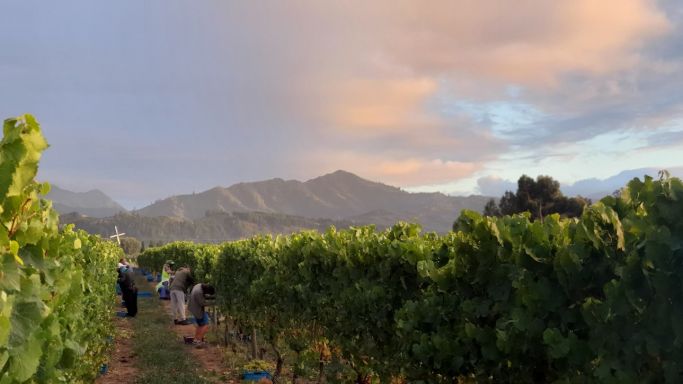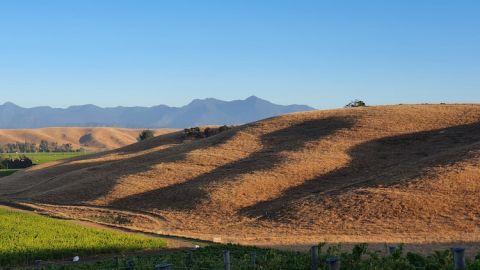22 April 2021 We're republishing this free in order to warn fans of Marlborough Sauvignon Blanc of likely shortages.
20 April 2021 Quality but not quantity is the theme throughout New Zealand wine regions in 2021, as Sophie Parker-Thomson MW reports. Supplies of the country's famous Marlborough Sauvignon Blanc, already low, are down by a good third. Above, hand-harvesting for her Blank Canvas label.
It was an early, dry season from the outset but frost and poor flowering weather shrunk yields. The resounding message is one of vastly reduced production, principally due to Marlborough’s small harvest, which will put real pressure on supply. There will be interesting challenges ahead for producers, distributors and retailers alike.
New Zealand’s winegrowing regions span 1,787 km (1,110 miles) between its northern- and southern-most vineyards (from The Landing in Northland to Grasshopper Rock in Alexandra, Central Otago). With a full 10° of latitudinal spread, one would imagine very different vintage conditions from region to region. But 2021 saw common vintage themes across the country. Each of the respected winemakers quoted in this article reported an early and dry growing season, in many cases record-breakingly so, and most regions, apart from Hawke’s Bay and Central Otago (where both 2019 and 2020 were also very low-yielding vintages), highlight the small volumes harvested as a defining feature of the vintage. But the quality message across all regions was loud and clear.
The situation in Marlborough is unprecedented and will engender severe supply issues; 2020 inventories are already severely depleted or even exhausted entirely thanks to a lockdown-induced thirst for Sauvignon Blanc globally. Many are comparing the current supply/demand landscape in Marlborough to the oversupply of 2008, but in reverse and yet more dramatic. With this region producing 75% of the country’s wine, it will obviously have a significant impact on New Zealand wine production and export figures this year. However, in happy contrast to the 2020 harvest, there were minimal restrictions due to the pandemic with much of the country operating under relatively liberal alert levels. But labour shortages due to closed borders continue to cause challenges for the industry.
From north to south here is a brief regional rundown.
Northland
Northland is the warmest winegrowing region in the country and is relatively tiny (71 ha/175 acres). Samuel Marsden planted the first vines here 200 years ago. Winemaker Ben Byrne of The Landing recalls that picking started on 25 January, a week earlier than the already-early 2020 season. Byrne comments it was a ‘breeze’ of a vintage with yields down between three and 30% on average.
Auckland
2021 marked Michael Brajkovich MW’s 40th vintage at Kumeu River, with this harvest obligingly completing a hat-trick of exceptional vintages. The whole season was early, initiated by an early spring with a frost blip in late September causing some damage to vineyards. Dry conditions (2020 received just 60% of average rainfall) led to a 5 February start date for Kumeu River’s Cremant, which was the earliest start ever for Michael. Harvest was all wrapped up three weeks earlier than normal on 9 March. Yields were down by 30–40% but according to Michael the quality is ‘looking exceptional’.
Hawke’s Bay
Steve Smith MW of Smith & Sheth comments that New Zealand’s second-largest wine region enjoyed its fourth consecutive warmer-than-average vintage in 2021. Flowering was five to 10 days early and normal temperatures were experienced until the end of January (but maximum temperatures were significantly below the ideal parameters for bordeaux varieties). It was a drier-than-average season, but the moderate summer meant excessive vine stress was not evident. Harvest weather was reasonably stable and favourable, with Steve particularly excited about the potentially exceptional quality of the Chardonnay and ‘well-curated Syrah’.
Martinborough
Pinot Noir-focused Martinborough also experienced an early start to the growing season with Don McConachy at Devotus kicking off in the first week of March. Everything was about two weeks ahead of normal and Don blames the inclement weather at flowering for yield reductions of as much as 50% compared with the bountiful 2020 vintage. However, small bunches and small berries all promise to contribute to concentration and a real vibrancy that should translate well into the 2021 wines in bottle.
Nelson
From his new winery home in the Upper Moutere Hills, winemaker James Healy (who is still involved with Dog Point in Marlborough) explains that budburst was a week earlier than usual due to warmer winter temperatures and average rainfall. Poor flowering weather in most areas led to lower-than-average yields. A severe hail event on Boxing Day caused berry and leaf damage in both the Waimea Plains and hilly Moutere subregions (and devastated the hop and fruit industries). Summer was moderately dry, interspersed with brief rainfall which allowed good flavour and colour development. In essence, a small but high-quality harvest, with early estimates of 40% less volume.
Marlborough
The ‘early’ trend was also evident in Marlborough with a slightly early budburst, followed by some very cold nights with light frosts through September. This caused significant crop reduction in localised areas, and widespread minor damage to the buds reduced the number of bunches overall. Unstable weather patterns including some very cool nights during the December flowering period shrank the number of berries with widespread millerandage (variation in berry size within bunches) in all varieties.
The third year in a row of drought conditions (rainfall was only 31% of the usual December to March total) triggered a reduction in potential berry size in the looser bunches that resulted from flowering. Fortunately, there was enough rain in the headwaters to provide just enough water for those with irrigation. These dry conditions persisted and, combined with high wind, kept disease levels low. The very small yields meant a particularly early start to the 2021 harvest for everyone. Grapes for sparkling base wines were picked in early February and virtually everything was wrapped up before the end of March.
Matt Thomson of Blank Canvas estimates that Pinot Noir and Chardonnay yields are down 50%, Pinot Gris is as much as 60% down and the all-important Sauvignon Blanc is around 30–40% down on normal budgeted yields. To put this into perspective, an average of 40% reduction across Marlborough equates to 127,000 tonnes less fruit harvested (on a five-year average), or over 126 million fewer bottles of wine. The rest of New Zealand’s wine regions combined produced 98,605 tonnes last year.
The good news is that all varieties show great promise in terms of quality in such volumes as there are, with concentration in the Pinot Noir, great balance in the Chardonnay, and intensity and balance in the Sauvignon Blanc.
Central Otago
A cool summer resulted in small berries with great concentration and tannin structure, according to Valli’s Grant Taylor, to the point where he’s never seen wines so dark at this early stage. Unlike other parts of the country, early to mid summer were cool and wet with consequent powdery mildew to manage, but overall the fruit is in excellent condition with yields about average. This is greatly needed as Central Otago vignerons have been challenged with small crops the past two vintages. Vineyards in cooler subregions, such as Gibbston Valley and Wanaka, have yet to be harvested.

